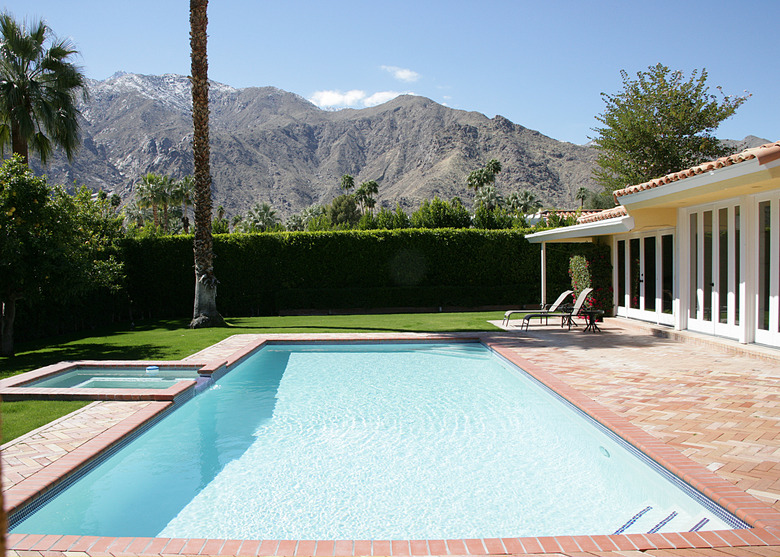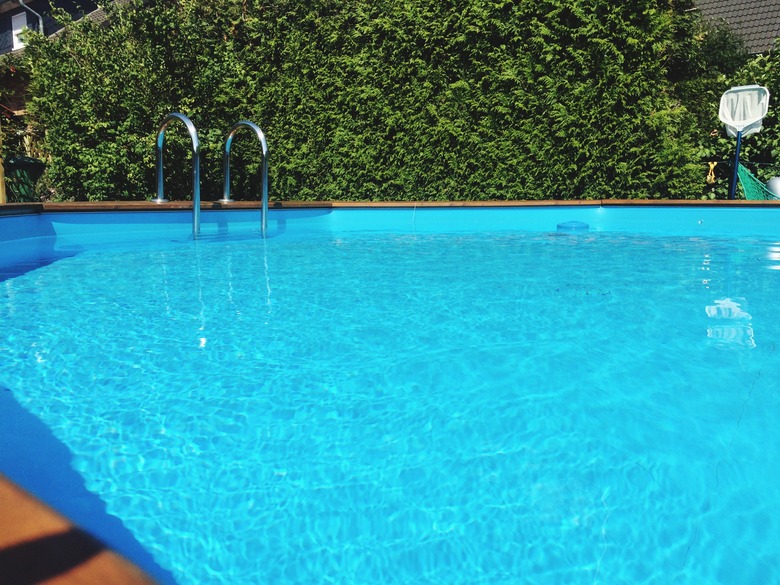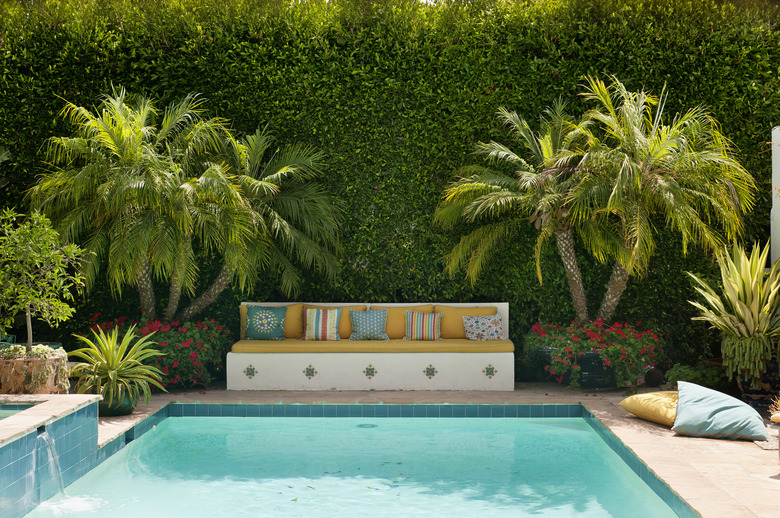A Homeowner's Guide To Swimming Pool Safety
If you have an in-ground or above-ground swimming pool, you need to conform to pool safety regulations established by state and federal law, some of which are written into local building codes. These regulations govern the design of the pool area and establish requirements for barriers, gates, steps, diving boards and pool covers. In particular, a federal law known as the Virginia Graeme Baker Pool & Spa Safety Act (VGB Act) requires anti-entrapment drain covers on all pool and spa drains as a drowning prevention method.
Pool safety measures are established with young children in mind. Each year, thousands of child drownings and near-drownings occur in the United States, and the majority of these involve children between the ages of 1 and 3. Of course, pool design is no substitute for adult supervision when young children are present, but sometimes, curious and energetic kids may find their way into the pool area when no one else is around. Pool safety measures are designed to prevent this as well as other mishaps.
Construct a Child-Proof Pool Barrier
Construct a Child-Proof Pool Barrier
Most state building codes require a barrier that completely encloses the pool area. The minimum height of the pool barrier is 4 feet, although higher is better, and it must be constructed in a way to prevent anyone from climbing it. This means constructing it with vertical slats rather than horizontal ones and placing the top rail on the pool side of the barrier unless it's more than 4 feet from the ground.
You can build a pool barrier from a solid material, such as brick, but when you do, you must make the surface completely flat with no protrusions that could allow a child to climb. When using slats or chain link, the maximum spacing in the links or in designs cut into the slats is 1 3/4 inches, which is small enough to prevent a child from getting a foothold. The maximum spacing between the bottom of the barrier and the ground is 2 inches, and when building a barrier with vertical slats, the maximum spacing of the slats is 4 inches.
The walls of an above-ground pool can serve as a barrier, but when you take this approach, you must secure the stairway to the pool deck to make it child-proof. One way to do this is to make the stairs removable so you can lock them away when no one is around, and another way is to enclose them with a barrier that has a locking gate. If the sides of your above-ground pool are low enough for children to climb them, then the pool needs to be fenced.
Restrict Access to the Swimming Pool
Restrict Access to the Swimming Pool
The pool gate must be self-closing and self-latching, and it must open to the outside of the barrier — that is, away from the pool. The latch mechanism must be on the pool side of the fence at least 40 inches above the ground, and if it's less than 54 inches high, it should be placed at least 3 inches from the top of the fence to make it inaccessible to anyone who reaches over the top of the fence. The only way you should be able to operate the latch from outside the pool area is to use a key, and the latch should be locked whenever the pool isn't in use.
It is permissible for the house to form one side of the pool barrier, but when you do this, you must provide pool alarms on all the doors that access the pool area. These alarms should be clearly audible in the immediate vicinity of the door as well as at least one other place in the house or on the property. Door alarms are recommended on all access doors to the pool, not just the ones in the house.
Consider Pool Safety Covers
Consider Pool Safety Covers
Installing a child-safe pool cover on your swimming pool is a way of adding layers of protection to the pool area, but it has to be the right type of cover. Simply throwing a solar pool cover on the pool may help keep the water warm and prevent evaporation, but it won't make the pool safer. In fact, it will make the pool more dangerous because any child that does fall in the pool could be prevented from surfacing by the cover and could drown.
Child-safe pool covers stretch tight across the surface of the water and are anchored to the pool decking. Some safety covers are so strong that they can actually support a vehicle, but you don't need such a strong one. Any cover that can support the weight of a person and is completely nonremovable by children qualifies as a safety cover, and it can also be used for winterizing your pool. Although not particularly budget friendly, a pool cover that automatically retracts is far more convenient than one you have to install and remove manually, and that convenience translates to enhanced safety since you're less likely to neglect to cover the pool after using it.
Because many state codes — if not all of them — require pool fencing, safety pool covers are largely optional, although the layers of protection they offer can only increase your peace of mind. If your budget prevents you from installing one, you might consider a safety net that stretches across the pool and anchors to the hooks set into the sides of the pool. A pool net costs $1,500 to $2,500 as opposed to the $4,000 to $7,000 you'll spend for a manually retractable pool cover.
Install Anti-entrapment Drain Covers
Install Anti-entrapment Drain Covers
The VGB Act is a federal law that came into effect in 2008 following the death of a child who was sucked into a pool drain and held there by the force of the water moving through the drain until she drowned despite the efforts of her mother to save her. The culprit was a flat drain cover, and to prevent a recurrence of this tragic incident, the VGB Act mandates that all public pool and spa drain covers must be curved — either convex or concave — to eliminate the suction force that causes child drownings. Failure to comply carries a heavy penalty, with fines that can be in the millions of dollars as well as possible jail time.
It isn't enough to just install anti-entrapment drain coverings if you don't have them already; you must also keep them in good condition. A broken drain cover can create a suction force just as powerful as one created by a noncompliant drain cover. Although the law applies primarily to pools and spas with a single drain opening, it's a good idea to supply compliant coverings on all the drain openings, but that shouldn't be difficult since flat drain covers are now pretty much a thing of the past.
Make the Pool Deck Slip-Proof
Make the Pool Deck Slip-Proof
An accident that happens on the side of the pool can be just as serious as one that occurs in the water, and the likelihood of one happening skyrockets when the pool deck is slippery. Some materials are more slippery than others, with smooth concrete, travertine and tile being at the top of the list. Fortunately, it's easy to apply a nonslip coating to these surfaces, and this is something you should do every year to make sure everyone using the pool has good traction.
If you're uneasy about coating your brand-new tile or travertine with an epoxy coating, an alternative is to lay a pool mat on the deck, especially in places that get the most traffic. A pool mat won't absorb heat and get hot like a cementitious or ceramic surface will, and that's good news for your feet on a hot day. A hot pool deck may not be as dangerous as a slippery one, but it's definitely less comfortable for feet.
Keep a First-Aid Kit Poolside
Keep a First-Aid Kit Poolside
The accidents that can happen around a swimming pool are often just nicks and scrapes, but sometimes they are serious, so you need a basic first-aid kit. It should contain bandages, gauze pads, a blanket, antiseptic ointments and wipes, aspirin, tweezers and scissors, among other things. The Red Cross suggests a few other optional items, such as a cleanup kit to prevent the spread of blood-borne pathogens, a flashlight, a fire extinguisher and even a carbon monoxide detector if the pool happens to be in an enclosed space.
Teach Kids to Swim
Teach Kids to Swim
No better protection exists for a youngster who has fallen into a body of water than the ability to swim, so if you have a backyard pool, take the time to teach your kids to swim from as early an age as possible. Enroll them in weekly swimming classes if possible or teach them at home, but either way, discourage the use of floaties, such as water wings and noodles. If your children don't yet know how to swim and you have floaties around the pool, you should throw them away or at least restrict their use to older children and adults who know how to swim and understand water safety.
The main reason to avoid floaties is because kids tend to rely on them, which impairs their ability to swim on their own. Children can be lulled into a false sense of security while using a float and may take dangerous risks. While using a float, the body is held in a vertical position in the water, which is not the correct orientation for swimming, and a child playing with a float who suddenly lets go is likely to drop to the bottom of the pool. Moreover, when littered around the pool deck, floaties constitute a tripping hazard.
Establish Rules and Routines for Safety
Establish Rules and Routines for Safety
No one likes rules, but they're a necessity around pools, which is why you'll always see them displayed on signs around a pool. It isn't a bad idea for homeowners to follow this practice because many people need the help of a sign to jog their memory. Whether you display the rules or simply make them known verbally, they should include:
- Do not enter without an adult
- No pushing
- No running
- No diving (unless there is a clearly demarcated diving area)
- Stay away from drains
- Don't swim alone
- Clean up the pool deck when finished
Ensure that people who use the pool know whom to contact in an emergency and make it a rule to contact that person when something happens. If you open your pool to neighbors and friends, it might be a good idea to post the contact person's phone number in a prominent place within the pool area. Pool accidents are potential legal and financial liabilities as well as health emergencies, so if you have a pool, it pays to stay in touch with the people using it.
References
- UpCodes: 3109.4 Residential Swimming Pools
- ARAG: 8 Rules for Having a Pool in Your Backyard
- U.S. Consumer Product Safety Commission: Safety Barrier Guidelines for Residential Pools
- In the Swim: California Residential Pool Safety Codes
- In the Swim: Pool Safety Cover Vs. Safety Net Vs. Safety Fencing
- Pool Safely: Simple Safety Steps Series: Ensure All Pools and Spas Have VGB-Compliant Drain Covers and Teach Your Children to Stay Away from Drains


